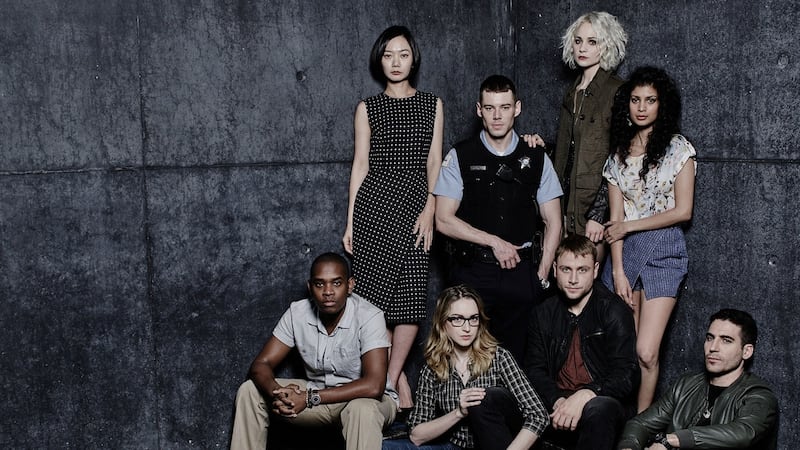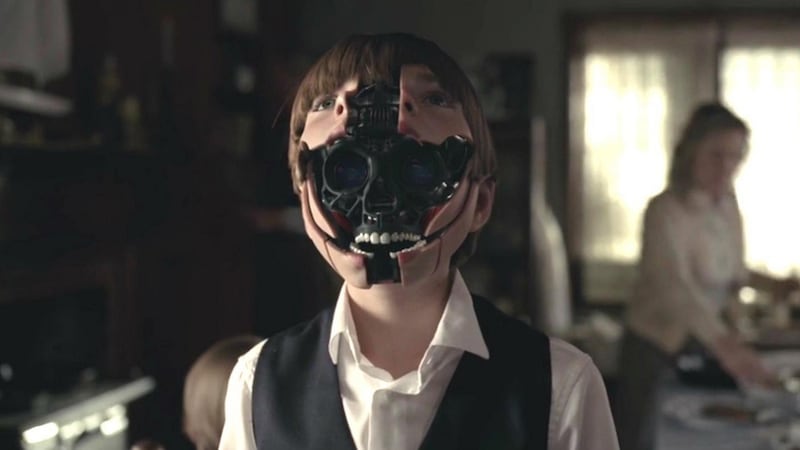Midway through the first season of Sense8 – a science fiction drama created by the Wachowski siblings and J Michael Straczynski – a mysterious man named Jonas asks a series of rhetorical questions. "What is 'human'?" he says. "An ability to reason? To imagine? To love or grieve?"
At a time when the boundaries between the human and the technological are more blurred than ever, Sense8 is one of a number of television shows that use science fiction as a vehicle to explore that most ancient of philosophical questions: What is it to be human?

Charlie Brooker's Black Mirror has probably been the most popular example of this in recent years. Each episode presents a tale, by turns dramatic, tragic, funny and terrifying, about realities we may face in the future. Most Black Mirror episodes revolve around a particular technological innovation and its complex consequences.
While some are more far-fetched than others – a terrorist organisation forcing the prime minister of the UK to have sexual intercourse with a pig on live television to save the life of a royal family member is one of the more realistic visions – the most powerful episodes are the most intimate.
In Be Right Back, an episode from the second series, Domhnall Gleeson plays Ash, partner of Martha (Hayley Atwell). After Ash dies in a traffic accident, Martha becomes hooked on a service that allows her to converse with a version of Ash constructed from his emails, tweets, texts and Facebook posts.
Reborn as a chatbot
Using the accumulated data of a life lived through technology, Ash is reborn as a chatbot. The more Martha talks to him, the more life-like he becomes. Eventually, Martha buys a life-sized robotic replica of Ash, which walks and talks just like the real thing. Soon though, the robot’s uncanny but ultimately imperfect replication of a loved one has repercussions. The attempt to stave off grief with technology is a failure.

Brooker returns to the question of grief in the most recent season, in an episode called San Junipero. San Junipero is a virtual world – forever stalled in 1987 – to which people can "pass over" after death by virtue of having their minds stored in a vast computer system. In San Junipero, Kelly and Yorkie are young, vibrant lovers. In reality, they are both old women, testing out the attractions of San Junipero in anticipation of their natural deaths.
After Yorkie passes over permanently to San Junipero, she begs Kelly to come with her. But Kelly refuses, angrily explaining the bond between her and her now-deceased husband with whom she had witnessed the heartbreaking death of their daughter at 39 years of age. They do not live on in San Junipero. The memory of those lives, those losses, causes Kelly to reject, temporarily at least, the virtual pleasuredome of San Junipero, where one might “spend forever somewhere nothing matters”.
Though the programme does backtrack its way to a happy ending, Kelly’s powerful evocation of what it means to live and lose the ones we love is a rare expression of existential commitment and an acknowledgement of the weight of the past. It’s about how, without loss, there is no gain – without leaving things behind, there is no going forward. “Everything we sacrificed,” says Kelly, “the years I gave him, the years he gave me.” Those years meant something, they were significant and valuable, because they ended and they could not be gotten back. If 1987 is forever, what is it worth?

Technological anguish
Perhaps the most inhumane thing about computers is that they don't age, they date. They have no sense of time distinct from the passing of microseconds. We imagine futures for ourselves, but computers cannot. Computers, as John Berger once said of animals, "have no anxiety for tomorrow, so they need no philosophy and they don't know anguish". However, shows like Channel 4's Humans and HBO's blockbuster Westworld set out to challenge the idea that the technological cannot know anguish.
Both Humans and Westworld present realities in which technologies – primarily humanoid robots – are used to satisfy particular needs and desires; mostly lust, laziness and a thirst for violence, but also grief, love and self-knowledge. The drama in both shows evolves out of the meeting of these "natural" or "human" emotions with technological interfaces, and the ability of those technologies to engage with or even manifest those emotions in turn.
Typically, this ability is first seen as entertaining or useful, but is then gradually revealed as uncanny – the apparent personhood of the robots becomes a threat to the unquestioned supremacy of “traditional” humans.
Both shows use grief as the factor that elevates the robots to something more than objects, while remaining something other than human. In Humans, William Hurt plays Dr George Millican, a former scientist whose memories of his deceased wife disappeared after a stroke. Odi, his out-of-date "synthetic," keeps those memories alive for him. "I look at Odi, I don't see a synthetic," he says. "I see all the years of care he gave us. All the memories he carried for me when I couldn't. He can't love me, but I see all those years of love looking back at me."
Love and memory
Leo is a higher-level robot, an evolution of Odi, driven by the memory of the death of his “mother,” and the pain it causes him. Leo is “human”; Odi, though invaluable, is not. Humanity is here revealed in the ability not just to reflect love, but to absorb it and express it – an ability, or attachment, that emerges from trauma, loss and pain.
Similarly, Westworld is a show completely haunted by memory and grief, with its two central characters – Evan Rachel Woods' Dolores and Thandie Newton's Maeve – both undergoing dramatic narratives of self-discovery centred on their ability to remember, and feel the pain resulting from, tragic events in their past. The loss of a parent, a lover, a child; these are the wounds we live with, the absences we internalise. Absences which become presences, which become part of who we are. Grief and mourning are not illnesses, not glitches in an otherwise functioning system, but processes that must be endured. There is no fix, because we are not broken.
Sense8 is different from other sci-fi shows because it presents a human evolution rather than a technological one. Eight strangers are suddenly linked by a strange mental connection that allows them to communicate with each other from their different corners of the globe. They each know the other's feelings, and can combine talents, languages and memories.
Human interconnectedness
In keeping with much of the Wachowskis' output, opulent set-pieces and shoot-outs are punctuated by long, philosophical conversations between characters. In its best moments, Sense8 captures a utopian sense of global human interconnectedness – physical, mental, cultural and sexual – which is visceral and intimate at the same time. Though the characters are avatars of loss, pain and betrayal, this sense of shared experience, different in detail but similar in kind, ultimately allows them to overcome the oppressive boundaries within which they have been forced to live.
Like all the best science fiction, Sense8 is about both recognising what essentially makes us human and imagining what an expanded notion of humanity might look like. At the heart of it, and all these shows, is a set of questions that desperately need asking at a time when fences are springing up anew and battles rage over all sorts of personal, social and national boundaries.












